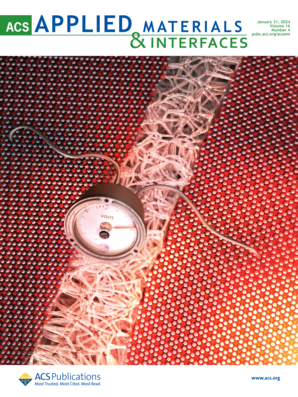CsPbBr3钙钛矿量子点的短配体修饰改善了光电催化性能
IF 8.2
2区 材料科学
Q1 MATERIALS SCIENCE, MULTIDISCIPLINARY
引用次数: 0
摘要
基于CsPbBr3量子点(QDs)的光电电池(PECs)由于其可调谐的光电特性和成本效益,在光电催化水分解方面表现出巨大的潜力。然而,在制备过程中,量子点表面的长链油酸(OA)配体阻碍了光生载体的有效分离和转移,限制了它们的实际应用。为了解决这个问题,我们采用固态配体交换技术,在CsPbBr3量子点上用3-巯基丙酸(MPA)取代OA。这种取代不仅显著减小了晶粒间距,而且有效地钝化了表面缺陷,从而降低了电阻,提高了稳定性,进一步促进了载流子的有效分离和输运。在模拟阳光照射下,MPA-CsPbBr3量子点光阳极的光电流密度为4.23 mA cm-2,在水下稳定工作长达11,600 s,耐久性显著。该性能明显优于目前报道的CsPbBr3量子点光阳极器件,远远超过传统的CsPbBr3薄膜光阳极。这项研究突出了短链配体交换的有效性,并为无机钙钛矿量子点在光电催化水分解应用中的应用提供了有价值的见解。本文章由计算机程序翻译,如有差异,请以英文原文为准。

Short-Ligand Modification in CsPbBr3 Perovskite Quantum Dots for Improved Photoelectrocatalytic Properties
Photoelectrochemical cells (PECs) based on CsPbBr3 quantum dots (QDs) exhibit significant potential for photoelectrocatalytic water splitting due to their tunable optoelectronic properties and cost-effectiveness. However, the long-chain oleic acid (OA) ligands on QDs’ surfaces during the preparation process impedes the efficient separation and transfer of photogenerated carriers, limiting their practical applications. To address this issue, we employed a solid-state ligand exchange technique, replacing OA with 3-mercaptopropionic acid (MPA) on the CsPbBr3 QDs. This substitution not only significantly reduces the grain spacing but also effectively passivates the surface defects, resulting in lower resistance and improved stability, which further facilitates effective carrier separation and transport. Under simulated sunlight irradiation, the MPA-CsPbBr3 QDs photoanode shows a photocurrent density of 4.23 mA cm–2 and operates stably underwater for a long period of time up to 11,600 s, showing remarkable durability. This performance is significantly better than currently reported CsPbBr3 QDs photoanode devices and far exceeds conventional CsPbBr3 thin film photoanodes. This research highlights the effectiveness of short-chain ligand exchange and provides valuable insights into the use of inorganic perovskite QDs for photoelectrocatalytic water splitting applications.
求助全文
通过发布文献求助,成功后即可免费获取论文全文。
去求助
来源期刊

ACS Applied Materials & Interfaces
工程技术-材料科学:综合
CiteScore
16.00
自引率
6.30%
发文量
4978
审稿时长
1.8 months
期刊介绍:
ACS Applied Materials & Interfaces is a leading interdisciplinary journal that brings together chemists, engineers, physicists, and biologists to explore the development and utilization of newly-discovered materials and interfacial processes for specific applications. Our journal has experienced remarkable growth since its establishment in 2009, both in terms of the number of articles published and the impact of the research showcased. We are proud to foster a truly global community, with the majority of published articles originating from outside the United States, reflecting the rapid growth of applied research worldwide.
 求助内容:
求助内容: 应助结果提醒方式:
应助结果提醒方式:


